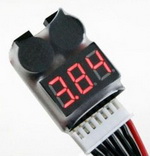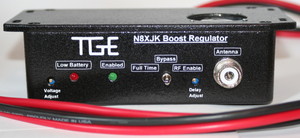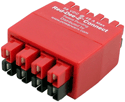110 VAC / Commercial Power
A typical station has a 110 VAC power supply delivering 13.8 VDC directly to a transceiver (rig). The power supply (PS) may be the older transformer based unit, or the later switching power supply. Transformer types are heavy; switchers weigh about 2-5 lbs.
Problem: A power outage would shut down the rig.
Use an Uninterruptable Power Supply (UPS) between the AC source and the PS. The UPSes are commonly used with computers (PCs). UPSes costs $100 to $200 plus.
 Use a Super Powergate from PowerWerx between the PS and the rig with a lead-acid battery attached. This effectively duplicates the UPS function, but on the DC side. The Super Powergate maintains a charging voltage to the battery and switches to the battery if it detects a loss of power from the PS. Super Powergate costs $140.
Use a Super Powergate from PowerWerx between the PS and the rig with a lead-acid battery attached. This effectively duplicates the UPS function, but on the DC side. The Super Powergate maintains a charging voltage to the battery and switches to the battery if it detects a loss of power from the PS. Super Powergate costs $140.
13.8 VDC (nominally 12 VDC) from battery
Power a rig directly from one (or more) 12VDC battery(ies).
Batteries can be lead-acid (refillable), Sealed Lead Acid (SLA), Absorbed Glass Mat (AGM) or any of the more exotic battery types. Deep cycle batteries are recommended for long duration use. Typical types are golf cart, motorized wheelchair, or marine (boat) batteries.
Batteries must be charged. a trickle charger is inexpensive, but can take 12+ hours to charge. Faster chargers use computer chips to charge at a higher level until almost full and then drop down to a trickle charge. They cost more, but recharges faster and prolongs the battery life.
Batteries in the field (Field Day, QRP, etc.) requires monitoring for status. Some options are:
- Place a meter across the output. A $10 analog needle type meter set to 15 VDC incurs minimal drain on the battery and requires no power to operate.
 Hendriks QRP Kits has a Battery Status Indicator (BSI) for $15. A three-color LED can be set to show good (11.5+V), marginal (10.5V-11.5V) and poor (>10.5V) battery status. It can be set anywhere in a range of 4.5V to 16V for use with other than 12V batteries. When in use it draws approx. 27 ma.
Hendriks QRP Kits has a Battery Status Indicator (BSI) for $15. A three-color LED can be set to show good (11.5+V), marginal (10.5V-11.5V) and poor (>10.5V) battery status. It can be set anywhere in a range of 4.5V to 16V for use with other than 12V batteries. When in use it draws approx. 27 ma. Model racing airplane supplies have a settable battery indicator for LithiumPoly (LiPo) batteries. With a minor modification (a 10:1 divider), it can show 12V and and has a settable audible alarm. These are available on eBay for as little as $3.00. See Cheap Chinese Electronics Modules
Model racing airplane supplies have a settable battery indicator for LithiumPoly (LiPo) batteries. With a minor modification (a 10:1 divider), it can show 12V and and has a settable audible alarm. These are available on eBay for as little as $3.00. See Cheap Chinese Electronics Modules
Battery boosters
- When batteries run low in the field and you don’t have a way to re-charge them, a battery booster (DC-DC boost converter) can be a life-saver. Two products on the market will boost a battery from as low as 9 VDC to a useable 13 VDC for up to 40 amps. Of course it drains a battery badly and requires a good re-charge later on, but it keeps you operating for a while longer.
 MFJ Battery Booster model MFJ-4416B. $150 street price.
MFJ Battery Booster model MFJ-4416B. $150 street price. TGE Battery Booster model N8XJK Super Booster. $210 street price.
TGE Battery Booster model N8XJK Super Booster. $210 street price.
Power connections
- The current standard for power connections are the Anderson PowerPole (PP) connectors. The PP connectors can handle 15, 30, 45 amps depending on the wire gauge used.
 Powerwerx.com PowerPole components
Powerwerx.com PowerPole components Powerwerx, West Mountain Radio and MFJ sells powerstrips with installed PPs. They come in 4, 6, 8, 10 or more connections with or without fuses. Price ranges from $60-150.
Powerwerx, West Mountain Radio and MFJ sells powerstrips with installed PPs. They come in 4, 6, 8, 10 or more connections with or without fuses. Price ranges from $60-150. Powerwerx sells TRIcrimp for about $40 specifically for PP. Highly recommended for secure connections.
Powerwerx sells TRIcrimp for about $40 specifically for PP. Highly recommended for secure connections.- Battery terminals should have pigtails of 1o/12 gauge with PP attached for ease of use.
- Make and keep a few cords 10 or 12 gauge wire, 6 feet long with PP at both ends for extending battery reach.
 Get two or more multiple-PP connector taps from Powerwerx for quick attachment of accessories that require 12VDC such as tuners, SWR meters, TNCs, voice and CW keyers, etc.
Get two or more multiple-PP connector taps from Powerwerx for quick attachment of accessories that require 12VDC such as tuners, SWR meters, TNCs, voice and CW keyers, etc.- PowerPole Assembly Instructions
- For low voltages such as 5 VDC or 12VDC, consider using a wall-wart or a USB hub powered with a wall-wart. Even an old USB 1.1 hub will do, as you’re not using the USB connection, only the 5V power out.
![]()